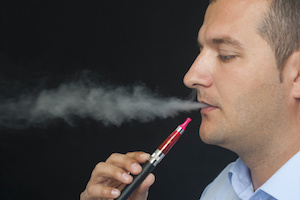 eCigarettes could be the new normal for employers!
eCigarettes could be the new normal for employers!
Employees who use eCigarettes want to know if they can use them at work, and employers have to decide whether to let them. Unfortunately, cigarette smoking remains the leading preventable cause of death in the United States, according to the Surgeon General Report in 2010. The electronic cigarette (eCigarette or e-cig) entered the picture in 2006. E-cigarettes differ from regular cigarettes in that what is inhaled is a vapor composed of water, nicotine, and propylene glycol instead of smoke. The Food and Drug Administration (FDA) announced April 24, 2014 that it deems e-cigarettes to be within their jurisdiction to regulate, along with cigars, hookah tobacco (flavored tobacco smoked via a water pipe), and some dissolvable tobacco products not already being regulated.
At this time, there is insufficient evidence to support the safety of long-term use of e-cigarettes or whether they are effective in helping smokers quit traditional cigarettes. Both safety and effectiveness are standard measures that need to be demonstrated in order for a treatment, such as the FDA-approved nicotine replacement therapy patches, to be adopted by tobacco-treatment professionals. Companies with smoke-free or tobacco-free policies in place who decide to ban e-cigarette use can easily add an e-cigarette section to their existing policies.
Employers are asking:
* Should they allow e-cigarette use at work since inhaling vapor does not have the health risks associated with inhaling smoke?
* If so, should they even encourage e-cigarette use as an alternative to smoking, or as a quitting aid?
* What if they have tobacco-free policies in place? Should they make an exception?
* How can employers communicate their policies on e-cigarettes?
Here are two options for employers:
* E-cigarette use should not be encouraged as a way to quit smoking until there is good empirical evidence that they are effective and safe as a quitting tool. Current research has led to evidence-based cessation treatment approaches that have proven to be highly cost-effective. Whether e-cigarettes are a tool that can be added to existing treatments has yet to be determined. Well-designed randomized control trials are needed to provide that information.
* E-cigarette use should not be allowed in any locations where use of traditional tobacco products (cigarettes, cigars, pipes and smokeless-tobacco products) is not permitted. While e-cigarettes do not technically produce “smoke,” they do produce a vapor or aerosol that contains exhaled nicotine, flavoring compounds and other chemicals. Until long-term exposure to these ingredients is proven to be safe, non-smokers should not have to be exposed to second-hand vapor. Another reason for banning e-cigarettes in smoke-free locations is that it is very difficult to determine from a distance whether a person is smoking a traditional tobacco cigarette or an e-cigarette.
